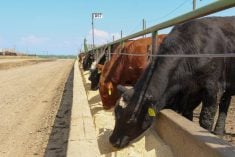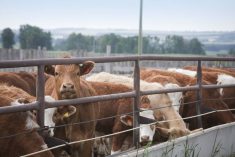As January unfolded, Alberta packers were buying fed cattle in the range of $275 to $280 on a dressed basis and $165 to $168 on a live basis. Prices are trading near 52-week highs and up approximately $10 on a live basis from mid-December. Feedlot margins are hovering between $40 to $60 per head. Market-ready supplies are rather snug on both sides of the border.
Strength in the fed cattle market has spilled over into the feeder complex. In central Alberta, mixed medium- to larger-frame steers with fleshier characteristics averaging 850 pounds were trading from $185 to $189, while steer calves averaging 500 pounds were trading from $235 to $240.
Read Also

Harvest wraps up and fall work begins
At the Eppich famly ranch in western Saskatchewan, the fall harvest was successful with few breakdowns, cows and calves have been sorted and a new tractor has arrived
Feedlots have been more aggressive on shorter-keep replacements in an effort to market them as fed cattle during the early spring. Mid-weight feeders from 600 to 800 pounds are relatively unchanged from last month as these cattle will come on the market during the summer when beef supplies are expected to be fairly burdensome.
Wholesale beef prices tend to soften during January and February as restaurant and retail demand eases after the holiday season. This may be limiting the upside in the fed cattle market in the short term. Later in winter, beef demand makes a seasonal high during March and April, which should keep the fed market well-supported.
Western Canada numbers
Alberta and Saskatchewan cattle-on-feed inventories as of Dec. 1 were 1.134 million head, up nine per cent from Dec. 1 of 2018 and 18 per cent above the five-year average. We mentioned in the previous issue that feeder cattle imports during the fall were running above year-ago levels. The cattle on-feed report can be somewhat deceiving. It’s important to realize that during July through September, feedlot placements in the lighter weight categories (under 800 pounds) were down sharply from the same period a year earlier. Market-ready supplies during the first quarter of 2020 are expected to be similar to a year ago. Despite the heavy feedlot inventories, market-ready supplies are not as burdensome as one would believe by just looking at the cattle-on-feed report.
On the flip side, the report does indicate a burdensome supply situation for the summer. For the combined months of June and July, market-ready supplies in Alberta and Saskatchewan could be a whopping 100,000 head above a year ago. From a supply situation, the market will move from one extreme to another within a five-month timeframe.
A similar placement pattern has occurred in the U.S. Therefore, during the first quarter of 2020, feedlots should be more aggressive with their price insurance or hedging program for the remainder of the year. The live cattle futures exhibit a behaviour known as the “constellation of prices.” This is where the tightness in the nearby positions pulls up the deferred futures contracts.
As of late January, the April live cattle futures were trading in a range of $126 to $128, which is essentially contract highs. The August contract is also near contract highs in the range of $115 to $117. When the August delivery period rolls around, the August live cattle futures will likely be trading in the range of $104 to $106, about $12 lower than current levels. Don’t expect the August contract to trade up to the April highs come summer.
A different feeder market
The feeder market is reflecting a totally different price structure. Remember the feeder cattle contract is the live cattle five months forward. For example, the March 2020 feeder contract reflects the August 2020 live cattle. Again, as of late January, the March 2020 feeder cattle futures were hovering around $146, which was about $10 off contract highs. However, the October 2020 feeder contract was near $156, a $10 premium to the March contract.
This explains the price structure for the mid-weight feeder cattle. The market for 600- to 800-pound feeders has a risk discount due to the weaker live cattle futures during the summer. Cow-calf producers can’t expect too much upside for these weight categories. I’m expecting the feed barley market to percolate higher into the spring as well so there will be no reprieve for input costs.
The 2019 calf crops in Canada and the U.S. are expected to experience a minor year-over-year decline. Recently, featherlight steer calves from $450 to 500 pounds were trading in the range of $245 to $250 while steers from 350 to 400 pounds were trading near $275. Feedlots are more aggressive for these lower-weight feeders because the yearling market next fall has potential to be very strong. I wouldn’t be surprised to see 850-pound steers reach up to $200 during August and September. Barring adverse weather, I’m expecting feed barley to trade sub-$200 in Lethbridge during the third quarter of 2020. The year-over-year decline in the calf crop along with weaker feed grain prices will cause yearlings to be “red hot” in late summer and early fall.
Cow-calf and backgrounding operators should be fairly well protected for their first- and second- quarter feeder cattle marketings. Feedlot inventories are 18 per cent above the five-year average. Very simply, demand is full. Secondly, the fed cattle market has potential to be very soft during the summer months. For calves that will be marketed during the fall of 2020 as yearlings, producers don’t have to be so risk-adverse because the fundamentals favour a very strong market.















